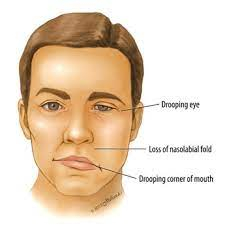



Introduction
• Aetiology is not definitely known. Herpes simplex virus and herpes zoster are suspected.
• Pathologically, oedema and swelling of the nerve occur within the facial canal, often at stylomastoid foramen. Severity in a given case varies from simple conduction block to severe axonal degeneration.
Clinical Features
• Onset is acute. Sometimes history of exposure to cold is present. Mild pain at stylomastoid foramen for a few days may precede the palsy. Examination shows isolated lower motor neurone facial paralysis with or without loss of taste sensation at anterior two-third of tongue and hyperacusis.
Features of Lower Motor Facial Nerve Palsy
• Paralysis of all the muscles of facial expression on the side of palsy.
• Drooping of corner of mouth, effacement of creases and skin fold on the affected side.
• Weakness of frowning and eye closure as the upper facial muscles are weak.
• Drooling of saliva from angle of mouth.
• On asking the patient to show his teeth, the angle of mouth deviates away from the side of lesion.
• Upon attempted closure of the eyelid, the eye on the paralysed side rolls upwards (Bell's phenomenon).
• Corneal ulceration due to inability to close the eye during sleep.
Differential Diagnosis
• Herpes zoster of VIIth nerve (Ramsay Hunt syndrome).
• Middle ear disease with Vllth nerve compression.
• Trauma.
• Occasional case of intracanalicular Vllth nerve neuroma.
• Diabetic mononeuropathy.
• Upper motor neurone Vllth nerve palsy as in cerebrovascular accident (frontalis is spared, normal furrowing of the brow is preserved, and eye closure and blinking are not affected).
Investigations
• No specific confirmatory diagnostic procedure.
• Electrophysiological tests (EMG or electromyography) may help in prognostication.
• To rule out alternate diagnosis, appropriate diagnostic procedures maybe necessary.
Precaution
• Adhesive tape to keep the eye closed so as to prevent corneal ulceration.
Prognosis
• Majority recovers very well (by more than 90%) if recovery starts within a few days. Poor prognosis is seen in elderly who show delayed recovery, those with hyperacusis or loss of taste sensation, and when severe axonal degeneration is suggested on electrophysiological studies. If no signs of recovery are seen at the end of 3 months, alternate diagnosis will have to be considered (VIIth nerve neuroma).
• Those who recover may show signs of anomalous reinnervation resulting in "crocodile tears", "jaw-winking", etc.
TREATMENT AT DR. SOHAN LAL CLINIC
The integrated POLYCLINIC facility offers patients to select their treatment either from the Department of Homeopathy or from the Department of Medicine.
We provide scientific, research-based, and professional services to people across the world, aiming to achieve the highest success rate.
